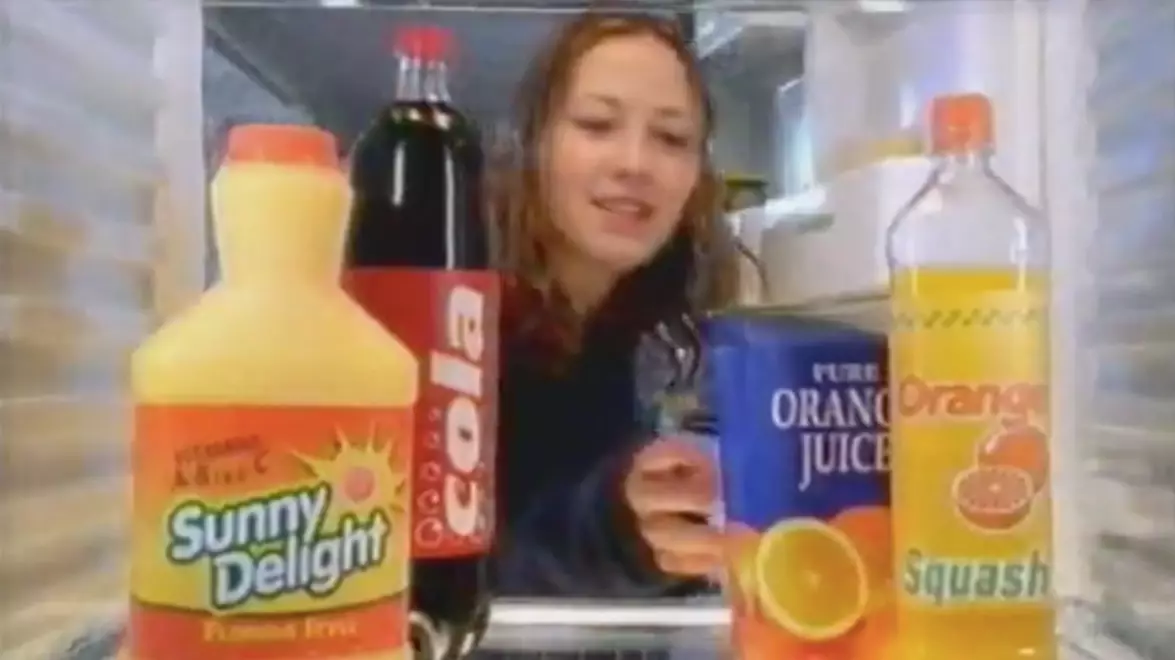
Long before stoneless avocados and the curly kale craze, before Jamie Oliver got his healthy hands all over our school lunches, the 90s was a weird and wonderful era for food.
Not only did school bosses think Potato Smiles and Turkey Twizzlers constituted a balanced meal, but back at home a similar story unfolded. It was a time when everything we ate was neon and/or made up of at least one thousand ingredients.
No other product summed up this period better than the orange nectar that was Sunny Delight. Along with the myth that those alien goo toys had babies, the story that SunnyD's original recipe was banned because it turned a kid's skin orange circulated and became somewhat of an urban legend.
Going viral before viral was a thing, the story spread like wildfire in school playgrounds across the country. But unlike the alien goo rumour, it turns out that SunnyD's skin-staining effects were completely true.
Advert
After doing well with kids in America, the drink made its way across the pond and overtook the vast majority of other drinks in terms of popularity. Any 90s kid will remember the artificial, outrageously sweet juice drink. The original SunnyD came in two flavours: Florida and California (aka radioactive orange and neon yellow).
According to The Tab, by the late 90s sales of SunnyD came third only to Coke and Pepsi in the UK and it was even the 12th best selling grocery product. In other words, people couldn't get enough of those delicious, delicious E-numbers.
These were the glory days for the drink, when parents bought it for their kids thinking it was a healthier option than fizzy pop. At the time, no one gave second thought to the fact that it was only 5 percent citrus juice and a lot of sugar, water, vegetable oil, thickeners, flavourings, colourings and other additives that make it look like the real deal. Which, let's face it, is why it tasted so damn good.
We all remember enjoying giant glasses of it, rejoicing to find the miniature bottles crammed into our packed lunches. But as soon as it shot up to the top, the illusion all came crashing down in 1999 when a story broke stating a girl's skin quite literally turned orange from drinking so much SunnyD.
Advert
The manufacturer, Procter & Gamble, was forced to admit that too much of it could send a child yellow in response to reports from a paediatrician in Wales that a four-year-old he had seen - who had been drinking 1.5 litres of the drink a day - was a 'yellowy colour'.
And while representatives were quick to point out that the change in skin colour was down to an over-consumption of beta-carotene, a red-orange pigment that occurs naturally in things like oranges and carrots, kids weren't climbing up the supermarket shelves in search of carrot juice. The kids wanted SunnyD and they wanted lots of it.

This controversy teamed up with rising concerns from parents about the sugary drink and a rather badly timed advert in which a snowman turned yellow after necking a bottle of the juice, and SunnyD started to lose its shine.
Advert
Although there's only one reported case of the drink causing the skin condition carotenemia, it was enough to get parents questioning just what the heck they were feeding their children. The controversy snowballed, sales dropped to half by 2001 and since then the company has tried a number of different formulas.
While it's still sold in major outlets across the UK and US, SunnyD has never returned to its former glory and, more significantly, it's never shaken the reputation as the drink that turned kids orange.